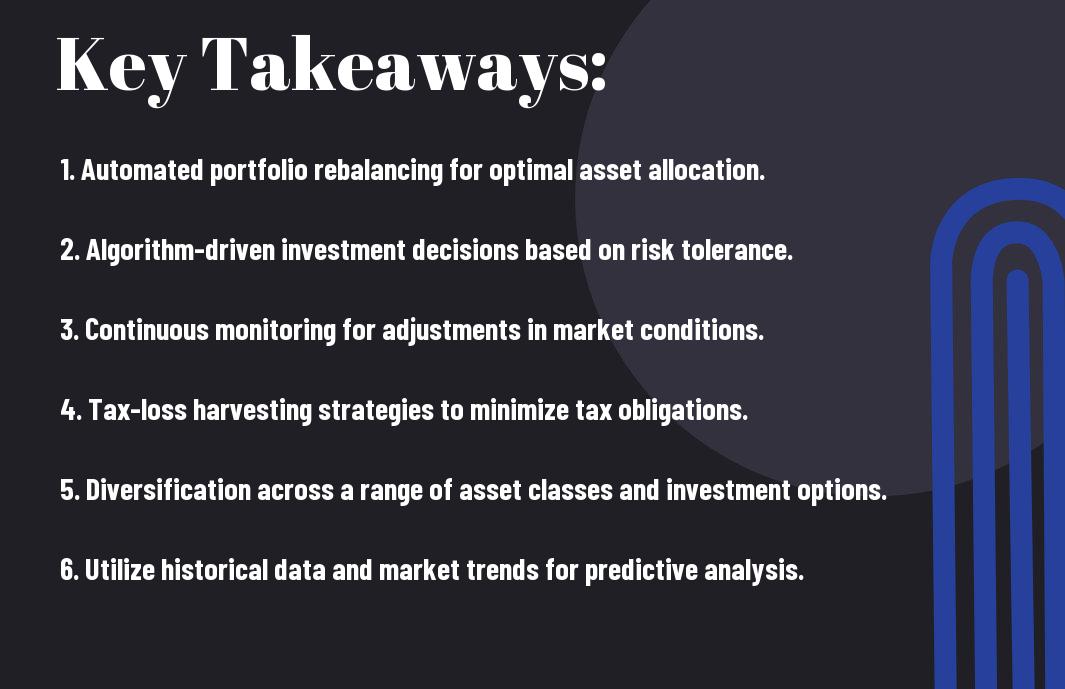With the rise of robo-advisors in the financial industry, understanding how these automated tools leverage algorithms to optimize investment portfolios is crucial for investors looking to streamline their decision-making process. Robo-advisors utilize sophisticated algorithms to analyze various factors, such as risk tolerance, financial goals, time horizon, and market conditions, to create customized investment portfolios for their clients. By automating tasks that were once traditionally done by human advisors, robo-advisors offer efficiency, cost-effectiveness, and diversified investment strategies. To probe deeper into how these algorithms work and impact investment portfolios, explore The rise of robo-advisors: Automating your investment portfolio.
Key Takeaways:
- Robo-advisors use algorithms to create and maintain optimized investment portfolios based on an individual’s financial goals, risk tolerance, and time horizon.
- These algorithms automatically adjust the portfolio to keep it aligned with the investor’s objectives and market conditions, without the need for manual intervention.
- By utilizing algorithms, robo-advisors can efficiently rebalance portfolios, minimize fees, and maximize returns over the long term.
- Robo-advisors leverage modern portfolio theory and statistical modeling to optimize asset allocation and ensure proper diversification across different investment categories.
- These algorithms are designed to minimize risk by spreading investments across a wide range of assets, while also maximizing potential returns by strategically allocating funds.
- Through the use of algorithms, robo-advisors can provide tailored investment solutions to a large number of clients at a fraction of the cost of traditional financial advisors.
- Overall, algorithms play a crucial role in empowering robo-advisors to deliver personalized and efficient investment strategies that can help individuals reach their financial goals.


Understanding Robo-Advisor Algorithms
Basics of Algorithmic Trading
Some of the most advanced financial technology used by robo-advisors is based on algorithmic trading. These algorithms work by using mathematical models and statistical analyses to make investment decisions without human intervention. They can process vast amounts of data in real-time to identify market trends and execute trades swiftly.
Key Components of Robo-Advisor Algorithms
For robo-advisors, the key components of algorithms include risk tolerance assessment, asset allocation, portfolio rebalancing, and tax-loss harvesting. These components are crucial in designing an investment strategy tailored to the individual needs and goals of each investor.
To ensure optimal performance, robo-advisors use sophisticated algorithms that continuously monitor the market, adjust portfolios based on changing market conditions, and optimize investments to minimize risk and maximize returns for their clients.
Portfolio Optimization Techniques
Asset Allocation Strategies
Keep in mind that robo-advisors utilize sophisticated algorithms to determine the optimal asset allocation for each investor’s portfolio. By analyzing factors such as risk tolerance, time horizon, and investment goals, these algorithms can create a diversified mix of assets that aims to maximize returns while minimizing risk.
Risk Management and Diversification
Techniques employed by robo-advisors for risk management and diversification involve spreading investments across different asset classes, industries, and geographic regions. This strategy helps to reduce the impact of market fluctuations on the overall portfolio performance. Additionally, automated algorithms continuously monitor and rebalance the portfolio to maintain the desired risk level.
Understanding the importance of risk management and diversification is crucial for achieving long-term investment success. Robo-advisors use advanced algorithms to implement these strategies effectively, ensuring that investors can achieve their financial goals with confidence.
The User Experience
Customizing Investment Preferences
To ensure a personalized investment experience, robo-advisors allow users to customize their investment preferences. From risk tolerance to investment goals, users can input their financial details and preferences to receive a tailored investment portfolio that aligns with their needs and objectives.
Monitoring and Rebalancing Portfolios
The core function of robo-advisors is to continuously monitor and rebalance investment portfolios to maintain optimal performance. By utilizing sophisticated algorithms, these platforms can automatically adjust asset allocations based on market conditions and the user’s risk profile. This hands-off approach ensures that the investment portfolio remains in line with the user’s goals and adapts to changing market dynamics.
Another crucial aspect of monitoring and rebalancing portfolios is tax-loss harvesting. Robo-advisors can strategically sell investments at a loss to offset gains, thereby reducing the investor’s tax liability. This tax-efficient strategy can help enhance overall portfolio returns over time while minimizing tax burdens.
Advanced Features and Future Trends
- Tax Loss Harvesting and Efficiency
| Tax Loss Harvesting | Efficiency |
Tax Loss Harvesting and Efficiency
Advanced robo-advisors leverage algorithms to optimize investment portfolios through tax loss harvesting. This feature involves selling securities at a loss to offset taxes on both gains and income. By strategically harvesting losses, robo-advisors can improve the after-tax rate of return for investors, ultimately maximizing efficiency in portfolio management.
Predictive Analytics and Machine Learning in Robo-Advising
On the forefront of innovation, robo-advisors are integrating predictive analytics and machine learning into their algorithms to enhance investment strategies. By analyzing vast amounts of data and identifying patterns, these platforms can predict market trends and make informed decisions in real-time. This proactive approach enables robo-advisors to optimize portfolios based on changing market conditions, ultimately offering more personalized and efficient investment solutions.
RoboAdvising is revolutionizing the way investors manage their portfolios by utilizing cutting-edge technologies to maximize returns and minimize risks. With advanced features like tax loss harvesting and predictive analytics, robo-advisors are at the forefront of optimizing investment portfolios and shaping the future of automated investing.
To wrap up
Now, we have explored how robo-advisors utilize algorithms to optimize investment portfolios. By analyzing risk tolerance, financial goals, and market trends, these algorithms can efficiently allocate assets and rebalance portfolios to maximize returns while minimizing risk. The use of sophisticated algorithms allows robo-advisors to provide personalized investment strategies tailored to individual needs, all while offering cost-effective and convenient solutions to investors. As technology continues to advance, robo-advisors will likely play an increasingly prominent role in the financial industry, making investment management more accessible and streamlined for a wider range of individuals.
FAQ
Q: What are robo-advisors?
A: Robo-advisors are automated online platforms that provide algorithm-driven financial planning services with little to no human supervision.
Q: How do robo-advisors utilize algorithms to optimize investment portfolios?
A: Robo-advisors use algorithms to analyze financial data, assess risk tolerance, and recommend diversified portfolios tailored to individual goals and preferences.
Q: What role do algorithms play in the decision-making process of robo-advisors?
A: Algorithms help robo-advisors make data-driven investment decisions, rebalance portfolios, and minimize risks while maximizing returns for investors.
Q: Are robo-advisors a suitable option for long-term investing?
A: Yes, robo-advisors are ideal for long-term investing as they provide automated portfolio management, continuous monitoring, and periodic rebalancing without human emotion or bias.
Q: How do robo-advisors ensure the security of investors’ funds and data?
A: Robo-advisors employ advanced encryption techniques, secure servers, and strict privacy policies to safeguard investors’ funds and sensitive information from unauthorized access or cyber threats.